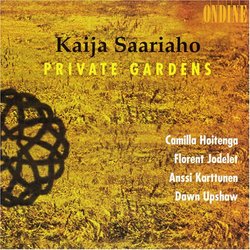| All Artists: Kaija Saariaho, Dawn Upshaw, Florent Jodelet, Anssi Karttunen, Reijo Kiilunen, Camilla Hoitenga Title: Saariaho: Private Gardens / Dawn Upshaw Members Wishing: 0 Total Copies: 0 Label: Ondine Release Date: 2/17/1998 Genres: Pop, Classical Styles: Vocal Pop, Opera & Classical Vocal, Chamber Music, Historical Periods, Classical (c.1770-1830) Number of Discs: 1 SwapaCD Credits: 1 UPCs: 761195090626, 076119509062 |
Search - Kaija Saariaho, Dawn Upshaw, Florent Jodelet :: Saariaho: Private Gardens / Dawn Upshaw
 | Kaija Saariaho, Dawn Upshaw, Florent Jodelet Saariaho: Private Gardens / Dawn Upshaw Genres: Pop, Classical
|
Larger Image |
CD Details |
CD ReviewsA consistently pleasurable and impressive Saariaho collectio Christopher Culver | 10/25/2005 (5 out of 5 stars) "The Ondine disc PRIVATE GARDENS collects four works, all played by their dedicatees, which epitomize the work of Finnish composer Kaija Saariaho in the 1990s. "Lohn" was written with Dawn Upshaw in mind like many of Saariaho's vocal works, as "Pres" was dedicated to cellist Anssi Karttunen like most of her cello works, and all works use electronics. In this day Saariaho was concerned primarily with timbre, in which exploration the electronics were a great resource. Recent Saariaho has eschewed electronics and has moved more towards melody, a development I'm still unsure about, but there is no doubt that what Saariaho was doing in this era was exciting. "Lohn" for soprano and electronics (1996) uses as its text a poem by Jaufre Rudel, the troubadour who also inspired the composer's 2000 opera "L'amour de loin". The soprano's part is relatively traditional with its diatonic scales, but the electronics give the piece its exotic sheen through mainly bell and chime-like sounds. Upshaw's performance, as in the DVD of "L'amour de loin" or the Sony disc with "Graal Theatre", shows her seemingly in perfect concord with the feelings of the composer. "Pres" for cello and electronics (1992) is a solo work in four movements based mainly on the cello part in "Amers", a sort of concerto for cello, orchestra, and electronics which the composer wrote earlier that year. Both pieces expand the possibilities of the cello by using a special microphone developed at IRCAM that can capture each of the cello's four strings in order to amplify or electronically alter their sound separately. This is a piece difficult to describe, consisting of continual crescendos and descents with various cello effects and electronic alterations, but it is truly one of the most awesome sonic experiences I have ever heard, and would have this disc rated five stars in spite of whatever other material is present. Anssi Karttunen again shows himself one of the greatest cellists of modern repertoire. "NoaNoa" for flute and electronics (1992) was written with the assistance of Camilla Hoitenga, who performs her. The piece takes its title from the Tahitian word for "odour" as was given to an engraving by Paul Gaugin. The "gimmick" of the piece is that as the flautist performs, spoken word heavily treated with electronics is laid on top, and the breathing of the speaker meets the breathing of the flautist. There is another performance of this piece on a BIS disc, but I regrettably haven't heard it yet. "Six Japanese Gardens" for percussion and electronics (1993-95) was inspired by places Saariaho saw during travels in Japan. Here Saariaho, in a rare turn, limits the timbral possibilities in order to emphasis a development of rhythm. If you've never heard Saariaho's work, the "Du Cristal ...A la fumee" reissue on Ondine might be a better introduction, since what she does with orchestra there is really amazing. PRIVATE GARDENS, however, should be one of the first things you pick up by this great Finnish composer." Intensely Interesting Sound Manipulations for Meditation Grady Harp | Los Angeles, CA United States | 10/12/2005 (5 out of 5 stars) "Kaija Saariaho is a prolific composer and it seems that almost everything she composes proceeds to disc! Her 'style' is difficult to define, because as soon as she has successfully entered one medium, she abruptly shifts to another - and with nearly equal success on every venture. She has surrounded herself with colleagues who understand her sonic language and so whether she composes opera, chamber music, large orchestral pieces, song cycles or, in the case of this recording, electronic music, her friends are at hand. This strangely wonderful recording moves from various instruments and pits them against or with electronically produced sounds. The first instrument is the human voice, and in this case the soloist is the enormously talented Dawn Upshaw. Saariaho places the voice in the hanging space of finger symbol sounds and atmospheres making 'Lonh for soprano & electronics' a mesmerizing, beautiful work. She then moves to the cello (again played by her regular friend Anssi Karttunen) in a three movement piece 'Près, for cello & electronics' in which at times it is difficult to discern which lines of sound flow from the strings of the cello and which from the electronic devices. The 'Noanoa for flute & electronics' displays the timbre of the flute played in every conceivable manner in tandem with electronic sounds (again, constant companion artist Camilla Hoitenga is the talented flautist). The final work involves percussion (Florent Jodelet) in 'Six Japanese Gardens for percussion & electronics' assigning music to Stone Bridges, Moss Garden, Rock Garden, Dry Mountain Stream, etc - six dissimilar and highly inventive combinations of percussive instruments with electronic modes. While the music on this recording may not demand the attention of the concert hall audience, it most assuredly touches the emotional center of the brain and heart and is some of the more successful meditative music to come from contemporary composers - and not dissimilar from that of Tan Dun. Grady Harp, October 05" Saariaho's best? Grady Harp | 07/12/2003 (5 out of 5 stars) "Dark, murderous eroticism, punctuated with whispers and sharp cries. highly recommended. Her best? possibly..."
|

 Track Listings (11) - Disc #1
Track Listings (11) - Disc #1